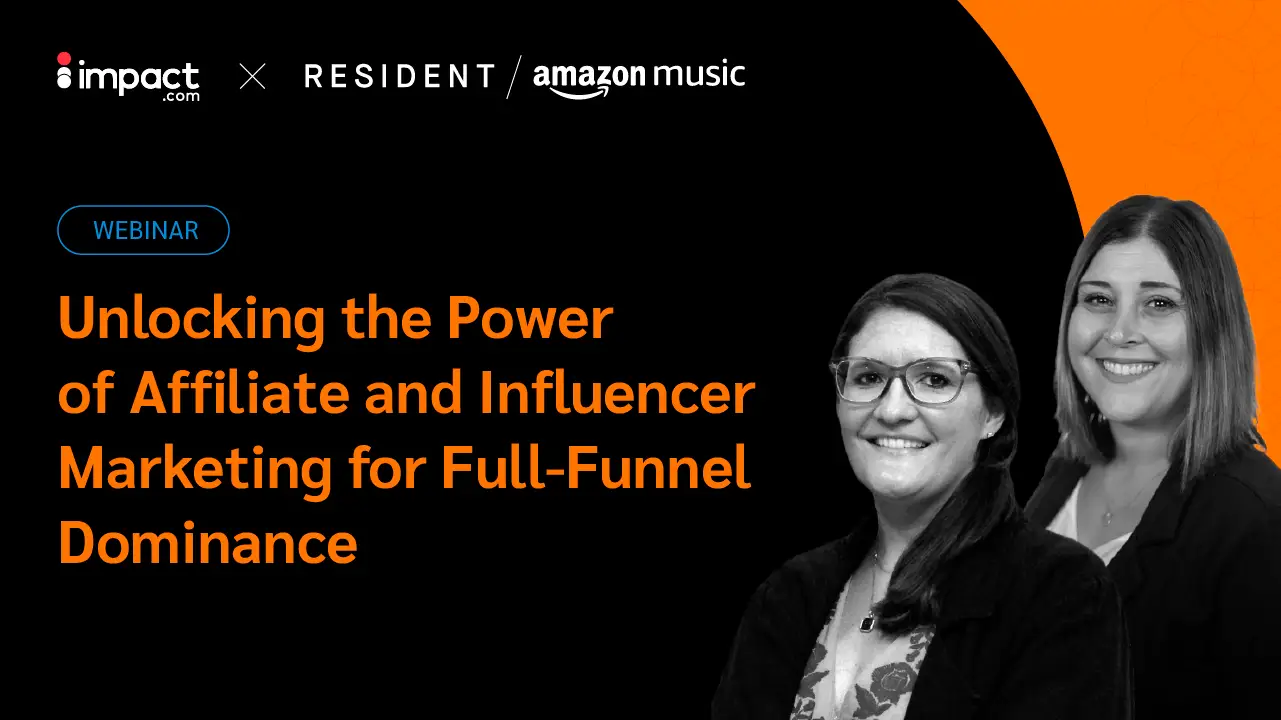Whitney Niesz (Amazon Music) and Jennifer Betz (Resident Home) transformed their partnership strategies to blend affiliate and influencer marketing, elevating their brand’s impact.
Jenn saw great upfront success with her engagement campaigns using influencer content to drive brand awareness for Resident Home mattresses. However, she faced a huge challenge finding that same success in converting with her creator partners.
Then she had a lightbulb moment. She could leverage creators’ user-generated content (UGC) to support content created on affiliate review sites. Resident Home built a content library from creators to distribute to affiliate partners.
That example shows one of the many ways brands can work with affiliates and creators across the funnel.
With affiliate marketing driving 16 percent of e-commerce sales and the global influencer marketing market size tripling since 2019, these two channels together can drive brand awareness and conversions efficiently and effectively.
The fusion of affiliate-driven traffic and influencer trust creates a powerful pathway to broaden reach, enhance credibility, and speed up conversions at every interaction point—ultimately linking the entire customer journey. Explore essential strategies for leveraging the full-funnel benefits of affiliate and influencer marketing for your brand.
6 best practices to reach customers across the funnel with affiliates and influencers
Brands that work with affiliates and creators across the entire customer journey are positioned to:
- Maximize their reach
- Resonate with diverse audiences
- Forge deeper connections with customers
- Turn passive observers into passionate advocates
How can a brand combine the strengths of affiliate and influencer marketing strategies? Industry experts share their insights, tips, and best practices to guide you through this dynamic approach.
The experts
- Whitney Niesz. Senior Global Affiliate and Influencer Marketing Lead, Amazon Music
- Jennifer (Jenn) Betz. VP of Affiliates, Influencers & Partnerships, Resident Home
1. Broaden the metrics of success
Focusing solely on sales and return on investment (ROI) leads to a narrow view of your marketing effort’s effectiveness. Whitney emphasized the need to consider engagement metrics.
Measuring full-funnel metrics is crucial in understanding a customer’s journey from initial awareness to conversion— and beyond retention and loyalty. It allows marketers to understand the effectiveness of their influencers and affiliates at each stage of the marketing funnel. Here’s why it’s important:
1. Comprehensive understanding of performance: Full-funnel metrics provide a more holistic view of your marketing efforts. They allow you to see whether an influencer or affiliate drives conversions and how they contribute to brand awareness, consideration, and loyalty.
2. Better attribution: By tracking full-funnel metrics, you can better attribute the impact of your influencers and affiliates. For example, an influencer might only drive a few direct conversions, but they play a key role in raising awareness or influencing consideration.
3. Optimization of strategy: Understanding performance at each stage of the funnel allows you to optimize your strategy. You can identify where influencers and affiliates are most effective and adjust your tactics accordingly.
4. Identifying potential issues: If there’s a drop-off at any stage of the funnel, full-funnel metrics can help identify the problem. For example, if many people are becoming aware of your brand but only a few are considering it, you might need to work on your messaging or targeting.
5. Long-term planning: Full-funnel metrics can support long-term planning by showing trends in how consumers interact with your brand over time. This can inform future strategies and partnerships.
Playing the long game
Integrating affiliate and influencer strategies is often a long-term endeavor. Jenn shares her views on Resident Home’s influencer strategy, “The ROI for influencer marketing is mainly seen in user-generated content and can take time to convert into sales.”
The temptation for brands to seek quick wins through short-term strategies is understandable, but investing in affiliate and influencer relationships ensures sustained growth.
Nurturing these relationships goes beyond financial incentives, extending into support, communication, and shared experiences. Such strategies can include:
- Extending exclusive access to new products and services
- Providing educational resources, updates, and industry trends
- Scheduling check-ins to address issues and provide feedback
- Inviting affiliates and influencers for co-creation opportunities on campaigns and content
These efforts result in a loyal network of affiliates and influencers dedicated to your brand. You create a community of trusted voices that amplify your brand’s message through authentic and engaging narratives.
This community becomes a powerful force for driving consistent results, leveraging their credibility and reach to engage existing audiences and captivate new ones continuously.
2. Customize your incentive strategy for each channel
By incentivizing a diverse group of affiliates and influencers, brands can tap into different audience segments and demographics, broadening their campaign’s scope and reach.
Jen shares how the team used product and financial incentives to recruit a wide range of partners who were motivated to promote the brand actively.
Innovative brands ingeniously incorporate affiliate linking into their influencer collaborations, maximizing their marketing budget. The dual-reward model compensates influencers with a fee for their content and a commission for the tangible sales their efforts generate.
This approach marries the authenticity and creative prowess of influencer marketing with the performance-driven and ROI-focused nature of affiliate marketing.
One of the most compelling benefits for affiliates is access to a rich library of user-generated content (UGC) from influencers. Brands providing affiliates with a curated selection of UGC equips them with a versatile toolkit for crafting compelling and persuasive narratives that drive conversion.
With more enriched partnerships, Dynamic Payouts—such as bonuses and commission tiers—allow your brand to incentivize affiliate partners based on the incrementality they drive.
3. Deliver evergreen content for full-funnel engagement
As Jenn mentions, ‘Diversifying your content and creators you work with are two ways you can optimize your program.’ Competition for consumers’ attention and engagement is fierce. So, strategically selecting various affiliates and influencers brings unique voices, audiences, and content styles.
Brands ensure their message is heard, resonates, and relates across different target audience segments. This diversity delivers evergreen content along the marketing funnel.
Evergreen content reflects the timeless, perpetually relevant nature of topics and information that resonates with audiences regardless of the current trend or season. It ensures that your message remains relevant and attracts an audience over time.
Potential customers stay engaged, educated, and nurtured towards conversion—irrespective of where they are in the buyer’s journey.
Whitney encourages brands to embrace this strategy.
Evergreen content across the buyer’s journey
Awareness stage: Influencers can create evergreen content introducing your brand or product to their audiences. This could be a blog post about the benefits of your product, a YouTube video reviewing your product, or an Instagram post showcasing your product in use. Because this content is evergreen, it will continue to raise awareness for your brand long after it’s first published.
Consideration stage: Affiliates can write comprehensive guides or reviews about your product that help potential customers decide. Again, because this content is evergreen, it will continue influencing potential customers for a long time.
Decision stage: Both influencers and affiliates can create evergreen content that convinces potential customers to purchase. This might be a detailed product comparison, a testimonial, or a case study demonstrating the effectiveness of your product.
Retention stage: Even after a purchase, evergreen content can still play a role. For example, influencers or affiliates could create how-to guides or tutorials that help customers get the most out of your product. This adds value for existing customers and can attract potential customers researching your product. They can also create content for complementary products, subscriptions, and upsells.
4. Tailor experiences for affiliates and influencers
While the mechanics of a convergence strategy might intersect, nurturing long-lasting relationships with affiliates and influencers needs to be distinct and personalized. Brands need to acknowledge each unique contribution to the narrative of powering the entire sales funnel.
- Affiliates are conversion experts who introduce and convert visitors into buyers.
- Influencers are content pros who drive awareness and engagement.
Jenn underscores the importance of tailoring experiences to each group by mentioning, ‘[affiliates and influencers] are very, very different from each other, and our goal at the end of the day is building relationships with both.’
Here are some strategies for both:
Influencers:
- Align with brand values: Choose influencers whose personal brand, content, and audience align with your brand values and target demographic. Their authenticity can greatly impact your brand’s image.
- Collaborative approach: Work collaboratively with influencers. Allow them creative freedom as they understand their audience best. Treat them as partners rather than just marketing tools.
- Provide value beyond money: Offer influencers more than just monetary compensation. This could be exclusive access to products, invites to events, or opportunities for cross-promotion.
- Long-term work: Instead of one-off campaigns, build long-term relationships that lead to more work. This shows commitment and can lead to more organic, authentic promotion.
Affiliates:
- Clear communication: Communicate your expectations, commission structure, and other important affiliate program details.
- Support for their role: Provide affiliates with the resources they need to succeed, such as marketing materials, product information, and training.
- Performance incentives: Offer bonuses or higher commission rates for high-performing affiliates to encourage them to put in more effort.
- Regular check-ins: Regularly check in with your affiliates to address issues or concerns and keep them engaged and motivated.
By investing in relationships through tailored experiences, affiliates and influencers feel valued and understood, fostering a sense of loyalty and enthusiasm for promoting your brand.
Jenn further highlights this point from the influencer’s perspective. In her words, ‘[creators] want to stick and keep working with a brand and provide that content. So, when you have that good relationship, you’ll find that the content you’re getting from them is fantastic.’
Whitney also acknowledges the role of human interaction in lasting relationships with affiliates and influencers.
5. Let data guide decision-making
As Whitney confirms, ‘Today’s buyers are more informed than ever. And having that full-funnel tracking visibility helps all teams.’ Invaluable insights empower brands and partners to make informed decisions, adapt strategies swiftly, and optimize campaigns to ensure maximum ROI.
Comprehensive data helps categorize influencers and affiliates by performance and aligns efforts with the most effective ones. Jenn discusses using data to pinpoint top-performing influencer types to partner with in future campaigns.
Improve your strategy with data
Furthermore, you can use reports strategically to highlight trends, identify improvement opportunities, and adjust payment strategies. Jenn shares how impact.com’s Contribution Report helped visualize influencer’s contributions. The team used this data to optimize payouts aligned with each influencer’s true value.
The report includes:
Touchpoint timeline: This shows each touchpoint a consumer had with your brand before purchasing. It can help you understand which partners drive initial awareness, influence consideration, and ultimately lead to conversions.
Partner contribution: This section breaks down each partner’s contribution to your overall sales. It can help you determine which partners are most valuable and where to focus your efforts.
Attribution analysis: The report also provides insights into how credit for sales is attributed among your partners. This can help ensure that all partners are fairly rewarded for their contributions.
Conversion path analysis: You can see customers’ different paths to conversion, helping you understand the customer journey and optimize your marketing strategy.
6. Automate your way to success
Automation drives progress— from streamlining processes and tracking performance to simplifying payments and fostering data-driven decision-making. Whitney states, ‘You can be a leader within your organization with partnership automation. And it’s really the way of our future.’
She further elaborates on the benefits of automation through a management platform, such as impact.com:
- Enables global tracking
- Simplifies payment processes
- Facilitates content sharing
Automation enhances agility, reinforces partner relationships, and drives superior campaign performance. Here are several ways you can automate these relationships:
- Affiliate management platforms: These can automate partner recruitment, tracking, payment, and communication.
- Influencer marketing platforms: These tools can help automate the process of finding, contacting, and managing influencers. They also provide analytics to track performance.
- Email automation: Use email automation tools to contact your partners. You can automate welcome emails, campaign updates, payment confirmations, and more.
- Automated reporting: Use tools that automatically gather and analyze data from your partnerships. This can help you easily track performance, calculate payouts, and identify areas for improvement.
- AI-powered discovery tools: AI can help identify potential partners who align with your brand values and target audience.
- Chatbots: Use chatbots to handle routine inquiries from your partners, freeing up your time to focus on more complex tasks.
- Smart contracts: In blockchain-based affiliate programs, smart contracts can automatically enforce the terms of your partnership and trigger payments when certain conditions are met.
Many brands like Walmart, Uber, and American Express find value in impact.com’s AI-optimized platform. Their teams used advanced automation tools to power affiliate and influencer management, driving business success.
Questions asked following the webinar
Jenn: The contribution report impact.com is a powerful tool. We look at the percent of orders that the creators influence. In addition, we look at the customer journey in the transaction reports by clicking on the action ID to see the path.
Whitney: Engagement HVAs are powerful (likes, comments, shares, views, clicks), with the icing on the cake being BOFU conversions/revenue, but it comes at various stages of the sales cycle. Consider creating per-post run rates and determine what actions you generate based on content and audience. Set yourself up for success and develop your full-funnel values to benchmark growth and build your program. Test and learn, double down, and repeat!
Jenn: In your contracts, you’ll want to require that the creator not only loads the content in the platform but that they also send you the files. You could setup a process where they load it in Google Docs, Dropbox, or another asset tool your company uses. In addition, some platforms allow you to download content directly from the platform.
Jenn: Only if you state that in your contract with the creator. They would need to agree to this.
Jenn: For sure. You can blocklist it and safelist the code for the creator it’s intended for. You would still want to watch it closely to ensure the code doesn’t go viral.
Working with affiliates and influencers as part of your strategy
Brands investing in affiliate and influencer marketing can gain significant benefits. In affiliate marketing, brands reward based on performance, reducing the risk of wasted funds. Affiliates help access new audiences, and tracking systems show which drive traffic and conversions.
Influencer marketing allows brands to capitalize on influencers’ established trust with their followers. Influencers’ recommendations hold sway, enhancing consumer trust in the brand. Collaborating with influencers can significantly enhance brand visibility and reputation. Their authentic content resonates with audiences, driving higher engagement rates.
These marketing strategies must be considered to avoid missed opportunities. Affiliate and influencer marketing drive sales, building trust with customers. In the digital age, leveraging these tactics gives brands a competitive edge.
Use these impact.com resources for more insights into creating a winning strategy that integrates affiliate and influencer marketing:
- Awareness to retention: How affiliates and influencers connect the entire customer journey [Infographic]
- Partnerships marketing: How to achieve exponential growth and provide exceptional customer experiences [ebook]
- Affiliate and Partnerships Industry—Expert certificate path [Free PXA course]
- Getting started with Influencer Partnerships [Free PXA course]





